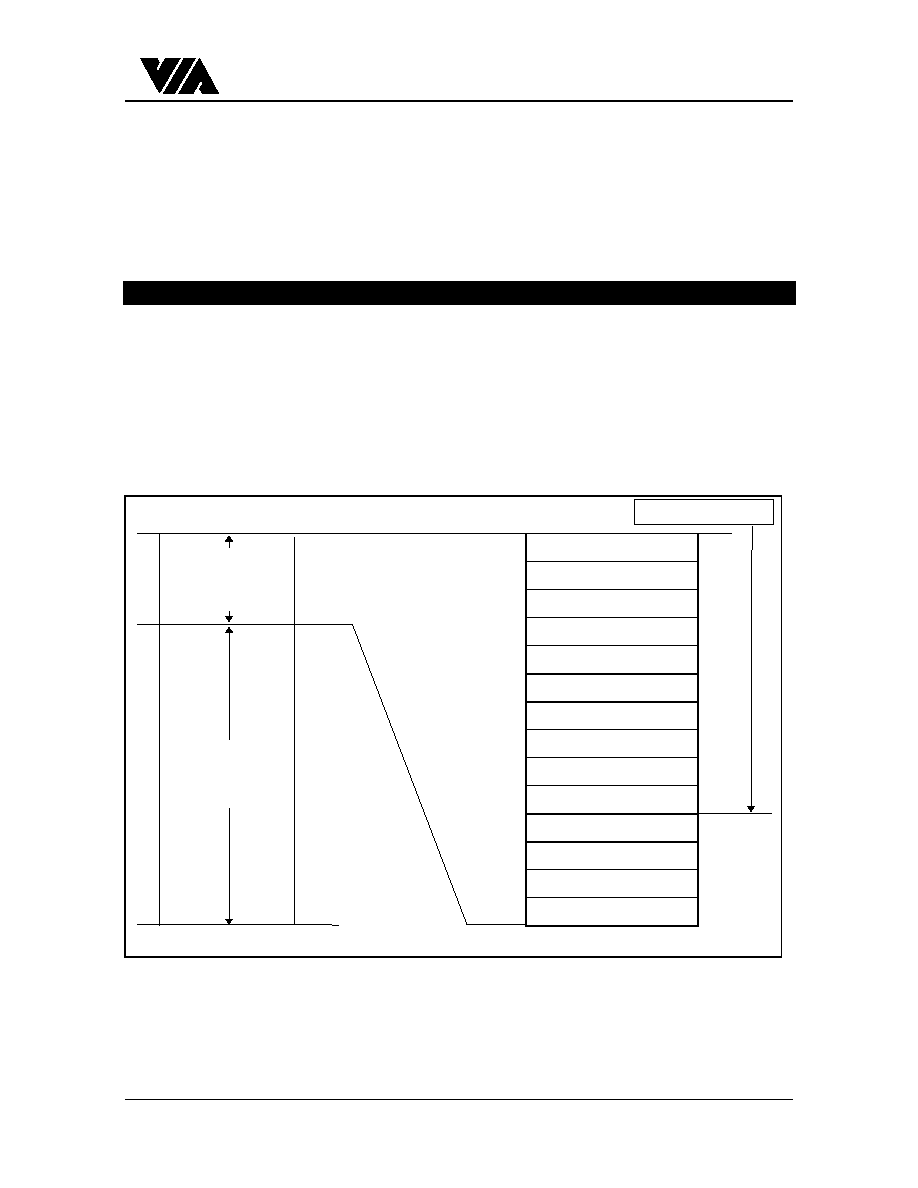 | –≠–ª–µ–∫—Ç—Ä–æ–Ω–Ω—ã–π –∫–æ–º–ø–æ–Ω–µ–Ω—Ç: VT82887 | –°–∫–∞—á–∞—Ç—å:  PDF PDF  ZIP ZIP |

1
VT82887
Real Time Clock
VIA Technologies, Inc.
FEATURES
∑
Drop-in replacement for IBM AT computer
clock/calendar.
∑
Pin configuration closely matches the
DS12887
∑
Totally nonvolatile with over 10 years of
operation in the absence of power
∑ Self-contained subsystem includes lithium,
quartz and support circuitry
∑
Counts seconds, minutes, hours, days, day
of the week, date, month and year with leap
year compensation
∑
Binary or BCD representation of time,
calendar and alarm
∑
12- or 24-hour clock with AM and PM in 12-
hour mode
∑
Daylight Savings Time option
∑
Intel bus timing
∑
Multiplex bus for pin efficiency
∑
Interfaced with software as 128 RAM
locations
- 14 bytes of clock and control registers
- 114 bytes of general purpose RAM
∑
Programmable square wave output signal
∑
Bus-compatible interrupt signals (IRQ#)
∑
Three interrupts are separately software-
maskable and testable
- Times-of-day alarm once/second to
once/day
- Periodic rates from 122
µ
s to 500 ms
- End of clock update cycle
DESCRIPTION
The VT82887 Real Time Clock is designed to
be a direct replacement for the DS12887. The
VT82887 is identical in form, fit and function
to the DS12887. It has 114 bytes of general
purpose RAM. Access to this RAM space is
determined by the logic level presented on
AD6 during the address portion of an access
cycle. An external crystal and battery are the
only components required to maintain time-of-
day and memory status in the absence of
power. A complete description of operating
conditions, electrical characteristics, bus
timing and pin descriptions follows.
PIN ASSIGNMENT
VT82887 24 PIN DIP
1
2
GND
3
4
5
NC
NC
AD0
AD1
24
V
CC
23
22
21
20
19
18
17
SQW
NC
RCLR#
NC
IRQ#
RESET#
RD#
6
7
8
AD2
AD3
AD4
AD5
AD6
AD7
GND
9
10
11
12
16
15
14
13
NC
WR#
AS
CS#
PIN DESCRIPTION
AD0-AD7
- Multiplexed Address/Data Bus
NC
- No Connection
CS#
- Chip Select
AS
- Address Strobe
WR#
- Write Strobe
RD#
- Read Strobe
RESET#
- Reset Input
IRQ#
- Interrupt Request Output
SQW
- Square Wave Output
V
CC
- +5 Volt Supply
GND
- Ground
RCLR#
- RAM Clear
OPERATION

2
VT82887
Real Time Clock
VIA Technologies, Inc.
The block diagram in Figure 1 shows the
pin connections with the major internal functions
of the VT82887. The following paragraphs
describe the function of each pin.
FIGURE 1: BLOCK DIAGRAM VT82887
POWER-DOWN/POWER-UP
CONSIDERATIONS
The Real Time Clock function will continue to
operate and all of the RAM, time, calendar
and alarm memory locations remain
nonvolatile regardless of the level of the V
CC
input. When V
CC
is applied to the VT82887
and reaches a level of greater than 4.25 volts,
the device becomes accessible after 100 ms,
provided that the oscillator is running and the
oscillator countdown chain is not in reset (see
Register A). This time period allows the
system to stabilize after power is applied.
When V
CC
falls below 4.25 volts, the chip
select input is internally forced to an inactive
level regardless of the value of CS# at the
input pin. The VT82887 is, therefore, write-
protected. When V
CC
falls below the level of
V
BAT
, the external V
CC
supply is switched off
and the external V
BAT
lithium energy source
supplies power to the Real Time Clock and
the RAM memory.
OSC
8
64
64
PERIODIC INTERUPT SQUARE WAVE
SELECTOR
SQUARE
WAVE OUT
POWER
SWITCH
AND
WRITE
PROTECT
BUS
INTERFACE
CLOCK/
CALENDAR
UPDATE
BCD/
BINARY
INCREMENT
REGISTERS A,B,C,D
CLOCK, CALENDAR
AND ALARM RAM
USER RAM
114 BYTES
AS
RD#
AD0-
AD7
WR#
V
BAT
V
CC
CS#
CS#
SQW
IRQ#
RESET#
RCLR#
PWGD
V
CC
DOUBLE
BUFFERED

3
VT82887
Real Time Clock
VIA Technologies, Inc.
SIGNAL DESCRIPTIONS
V
CC
-
DC power is provided to the device on
this pin. V
CC
is the +5 volt input. When 5 volts
are applied within normal limits, the device is
fully accessible and data can be written and
read. When VCC is below 4.25 volts typical,
reads and writes are inhibited. However, the
timekeeping function continues unaffected by
the lower input voltage. As VCC falls below 3
volts typical, the RAM and timekeeper are
switched over to the internal lithium energy
source. The timekeeping function maintains
an accuracy of
±
1 minute per month at 25
∞
C
regardless of the voltage input on the V
CC
pin.
SQW (Square Wave Output)
-
The SQW
pin can output a signal from one of 13 taps
provided by the 15 internal divider stages of
the Real Time Clock. The frequency of the
SQW pin can be changed by programming
Register A as shown in Table 1. The SQW
signal can be turned on and off using the
SQWE bit in Register B. The SQW signal is
not available when V
CC
is less than 4.25 volts
typical.
RCLR#
-
The RCLR# pin is used to clear (set
to logic 1) all 114 bytes of general purpose
RAM but does not affect the RAM associated
with the real time clock. In order to clear the
RAM, RCLR# must be forced to an input logic
of 0 (-0.3 to +0.8 volts) during battery back-up
mode when V
CC
is not applied. The RCLR#
function is designed to be used via human
interface (shorting to ground manually or by
switch) and not to be driven with external
buffers. This pin is internally pulled up.
TABLE 1: PERIODIC INTERRUPT RATE AND SQUARE WAVE OUTPUT FREQUENCY
SELECT BITS REGISTER A
t
PI
PERIODIC
SQW OUTPUT
RS3
RS2
RS1
RS0
INTERRUPT RATE
FREQUENCY
0
0
0
0
None
None
0
0
0
1
3.90625 ms
256 Hz
0
0
1
0
7.8125 ms
128 Hz
0
0
1
1
122.070
µ
s
8.192 kHz
0
1
0
0
244.141
µ
s
4.096 kHz
0
1
0
1
488.281
µ
s
2.048 kHz
0
1
1
0
976.5625
µ
s
1.024 kHz
0
1
1
1
1.953125 ms
512 Hz
1
0
0
0
3.90625 ms
256 Hz
1
0
0
1
7.8125 ms
128 Hz
1
0
1
0
15.625 ms
64 Hz
1
0
1
1
31.25 ms
32 Hz
1
1
0
0
62.5 ms
16 Hz
1
1
0
1
125 ms
8 Hz
1
1
1
0
250 ms
4 Hz
1
1
1
1
500 ms
2 Hz
AD0-AD7 (Multiplexed Bidirectional
Address/Data Bus)
-
Multiplexed buses
save pins because address information and
data information time share the same signal
paths. The addresses are present during the
first portion of the bus cycle and the same
pins and cycle paths are used for data in the
second portion of the cycle. Address/data
multiplexing does not slow the access time of

4
VT82887
Real Time Clock
VIA Technologies, Inc.
the VT82887 since the bus change from
address to data occurs during the internal
RAM access time. Addresses must be valid
prior to the falling edge of AS which the
VT82887 uses to latch the address from AD0
to AD6. Valid write data must be present and
held stable during the latter portion of the
RD# or WR# pulses. In a read cycle the
VT82887 outputs 8 bits of data during the
latter portion of the RD# pulse. The read cycle
is terminated and the bus returns to a high
impedance state as RD# transitions high as in
Intel timing.
AS (Address Strobe Input)
-
A positive
going address strobe pulse serves to
demultiplex the bus. The falling edge of AS
causes the address to be latched within the
VT82887.
RD# (Read Strobe)
-
The low active RD# pin
identifies the time period when the VT82887
drives the bus with read data. The RD# signal
is the same definition as the Output Enable
(OE#) signal on a typical memory.
WR# (Write Strobe)
-
The low active WR#
pin is used to indicate a write cycle. The data
on the bus AD0-AD7 at the rising edge of
WR# will be written into VT82887.
CS# (Chip Select Input)
-
The Chip Select
signal must be asserted low for a bus cycle in
order that the VT82887 can be accessed.
CS# must be kept in the active state during
RD# and WR#. Bus cycles which take place
without asserting CS# will latch addresses but
no access will occur. When V
CC
is below 4.25
volts, the VT82887 internally inhibits access
cycles by internally disabling the CS# input.
This action protects both the real time clock
data and RAM data during power outages.
IRQ# (Interrupt Request Output)
-
The
IRQ# pin is an active low output of the
VT82887 that can be used as an interrupt
input to a processor. The IRQ# output
remains low as long as the status bit causing
the interrupt is present and the corresponding
interrupt-enable bit is set. To clear the IRQ#
pin the processor program normally reads the
C register. The RESET# pin also clears
pending interrupts.
When no interrupt conditions are present, the
IRQ# level is in the high impedance state.
Multiple interrupting devices can be
connected to an IRQ# bus. The IRQ# bus is
an open drain output and requires an external
pull-up resistor.
RESET# (Reset Input)
-
The RESET# pin
has no effect on the clock, calendar, or RAM.
On power-up the RESET# pin can be held
low for a time in order to allow the power
supply to stabilize. The amount of time that
RESET# is held low is dependent on the
application. However, if RESET# is used on
power-up, the time RESET# is low should
exceed 200 ms to make sure that the internal
timer that controls the VT82887 on power-up
has timed out. When RESET# is low and V
CC
is above 4.25 volts, the following occurs:
A. Periodic Interrupt Enable (PIE) bit is
cleared to zero.
B. Alarm Interrupt Enable (AIE) bit is cleared
to zero.
C. Update Ended Interrupt Flag (UF) bit is
cleared to zero.
D. Interrupt Request Status Flag (IRQF) bit
is cleared to zero.
E. Periodic Interrupt Flag (PF) bit is cleared
to zero.
F. The device is not accessible until
RESET# is returned high.
G. Alarm Interrupt Flag (AF) bit is cleared to
zero.
H. IRQ# pin is in the high impedance state.
I.
Square Wave Output Enable (SQWE) bit
is cleared to zero.
J.
Update Ended Interrupt Enable (UIE) is
cleared to zero.
In a typical application RESET# can be
connected to V
CC
. This connection will allow
the VT82887 to go in and out of power fail
without affecting any of the control registers.
ADDRESS MAP
The address map of the VT82887 is shown in
Figure 2. The address map consists of 114
bytes of user RAM, 10 bytes of RAM that

5
VT82887
Real Time Clock
VIA Technologies, Inc.
contain the RTC time, calendar and alarm
data, and four bytes which are used for
control and status. All 128 bytes can be
directly written or read except for the
following:
1.
Registers C and D are read-only.
2.
Bit 7 of Register A is read-only.
3.
The high order bit of the seconds byte is
read-only.
The contents of four registers (A, B, C and D)
are described in the
"
Register
"
section.
FIGURE 2: ADDRESS MAP VT82887
TIME, CALENDAR AND ALARM
LOCATIONS
The time and calendar information is obtained
by reading the appropriate memory bytes.
The time, calendar and alarm are set
or initialized by writing the appropriate RAM
bytes. The contents of the ten time, calendar
and alarm bytes can be either Binary or
Binary-Coded Decimal (BCD) format. Before
writing the internal time, calendar and alarm
registers, the SET bit in Register B should be
written to a logic one to prevent updates from
occurring while access is being attempted. In
addition to writing the ten time, calendar and
alarm registers in a selected format (binary or
BCD), the data mode bit (DM) of Register B
must be set to the appropriate logic level. All
ten time, calendar and alarm bytes must use
the same data mode. The SET bit in Register
B should be cleared after time, calendar or
alarm have been written to allow the real time
clock to update the time and calendar bytes.
Once initialized, the real time clock makes all
updates in the selected mode. The data mode
cannot be changed without reinitializing the
ten data bytes. Table 2 shows the binary and
BCD formats of the ten time, calendar and
alarm locations. The 24-12 bit cannot be
changed without reinitializing the hour
locations. When the 12-hour format is
selected, the high order bit of the hours byte
0
SECONDS
00
1
SECONDS ALARM
01
2
MINUTES
02
3
MINUTES ALARM
03
4
HOURS
04
5
HOURS ALARM
05
6
DAY OF THE WEEK
06
7
DAY OF THE MONTH
07
8
MONTH
08
9
YEAR
09
10
REGISTER A
0A
11
REGISTER B
0B
12
REGISTER C
0C
13
REGISTER D
0D
127
0
00
OD
0E
13
14
7F
14 Bytes
Clock and Control
Status Registers
114 Bytes
Storage
Registers
Binary or BCD Input




